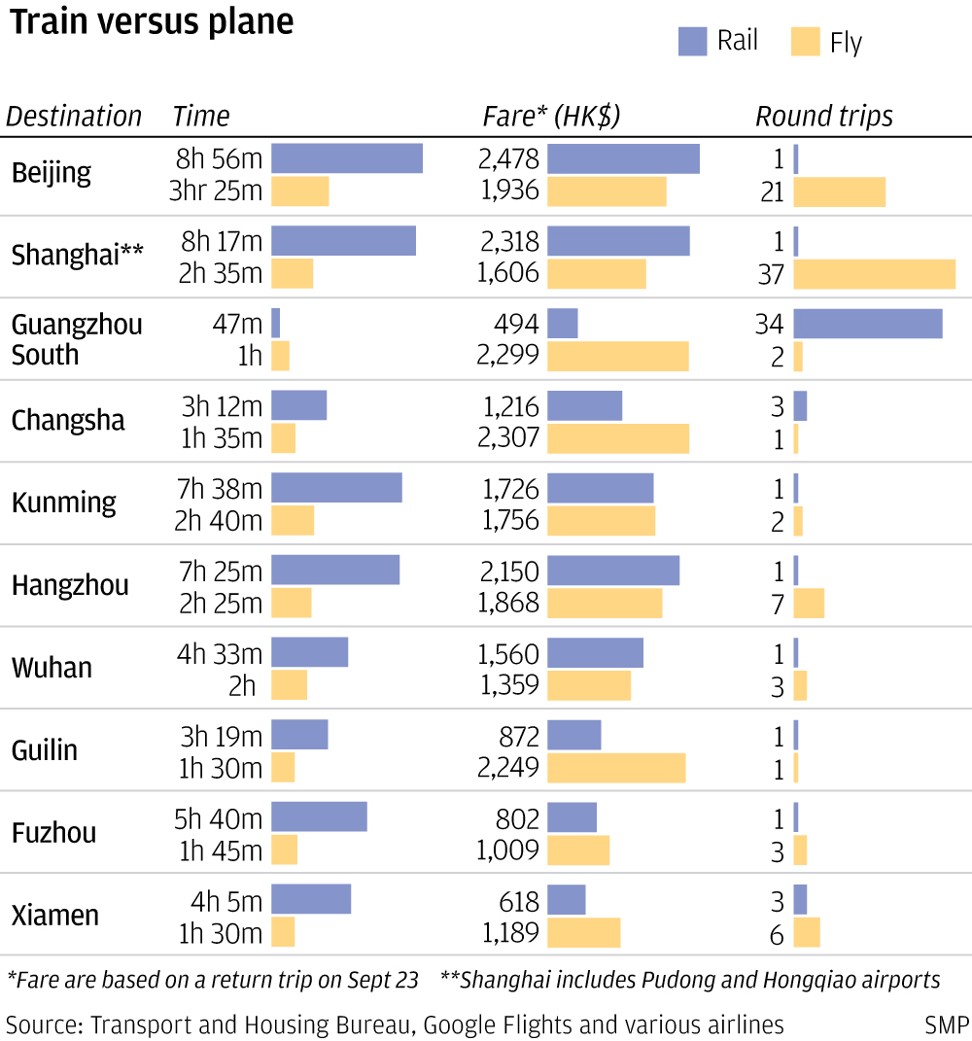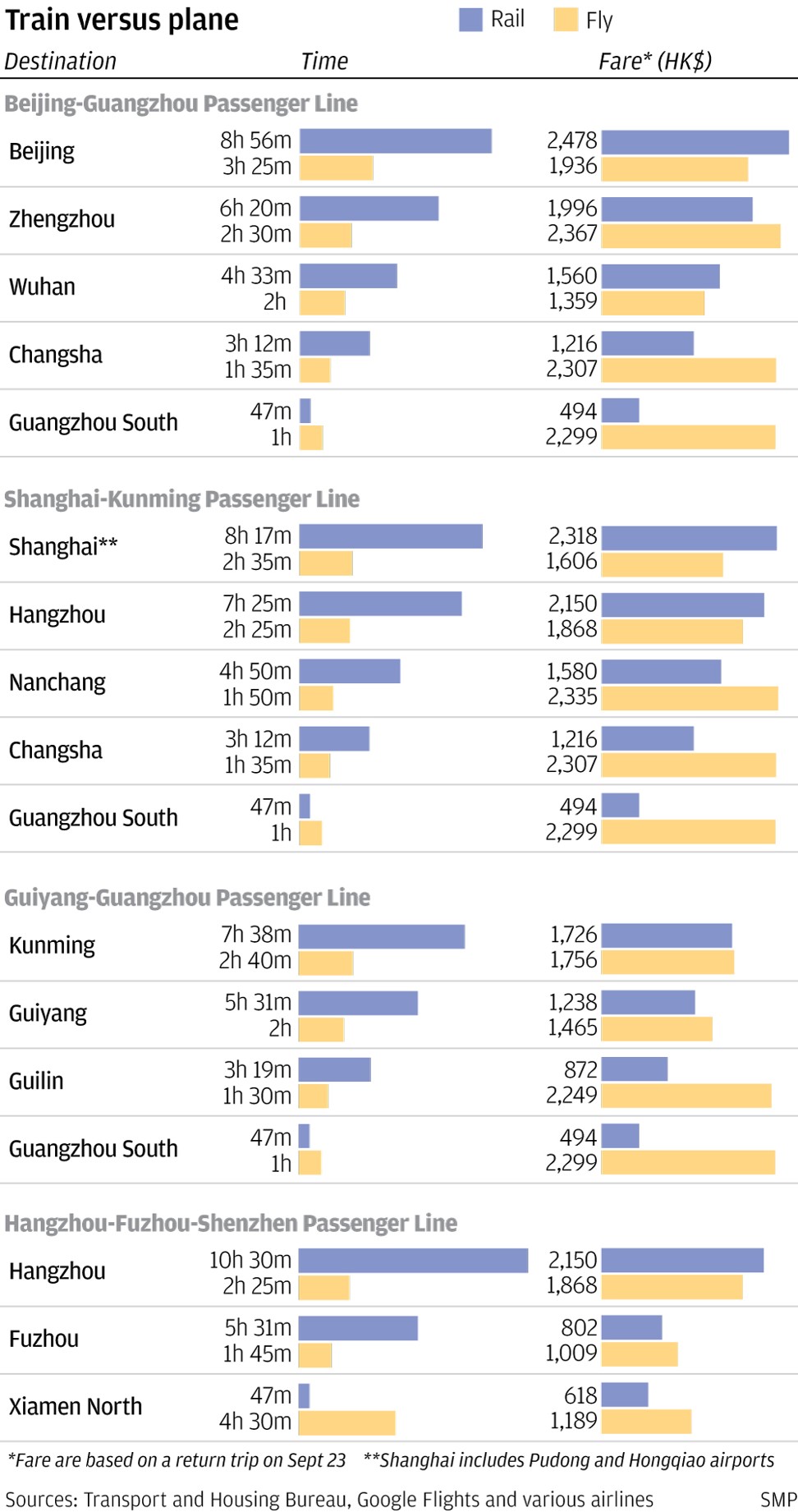
Plane or train: as high-speed rail link connects Hong Kong to 44 mainland Chinese cities, what are cheapest and fastest ways to get where you are going?
Post analysis shows in most cases, flying is better than train travel, unless you are heading to destinations that have few or no air services
When it comes to the 44 mainland destinations on Hong Kong’s new high-speed rail line, in most cases it would be cheaper or faster, sometimes both, to fly there.
But the HK$84.4 billion (US$10.7 billion) Guangzhou-Shenzhen-Hong Kong Express Rail Link to the mainland’s vast network does enjoy an advantage: it will offer travellers from the city a direct route to at least 15 destinations lacking an airport.

This includes towns and cities along the mainland’s eastern coast served by the Hangzhou-Fuzhou-Shenzhen line, where the train will pass through 13 towns with no airport, including Shanwei and Zhangpu.
For cities farther afield such as Beijing, Shanghai, Wuhan and Hangzhou, travellers are better off flying.
Delays notwithstanding, a return flight between Hong Kong and Beijing on the link’s opening day is priced as low as HK$1,936. A one-way journey typically lasts 3 hours and 25 minutes. And airfares in October would be even lower than on September 23, priced at HK$1,748.
In contrast, travel by train, both to and from the nation’s capital, costs HK$2,478 in total, and the journey spans eight hours and 56 minutes.
For the cities of Fuzhou, Guiyang, Kunming, Zhengzhou and Shijiazhuang, rail is a cheaper option but also takes more than twice as long as flights to those destinations. Airfares to those cities on September 23 are higher than rail prices.
Critics claim high-speed rail link to mainland will never be profitable
Lawmaker Yiu Si-wing, who represents the tourism sector, said cities with vibrant business activities such as Beijing and Shanghai already offered many flights from Hong Kong, so rail would be a better option for those travelling to cities that have few or no air services.
Yiu believed Hong Kong outbound tourism would grow 20 per cent, saying the city’s travel agencies were preparing to set up tours in which visitors ride the link.
“There are a lot of people who want to take a ride because by now the rail link is so well known,” he added.
The rail system would also make it easier for people living in second or third-tier cities and provinces to come to Hong Kong, he said.
About 66,400 people are expected to use the high-speed service daily to take short-haul trips to Shenzhen, Dongguan and Guangzhou in the Pearl River Delta. Some 13,700 are tipped to be daily users of the link’s long-haul service.
Among the short-haul travellers, about 16,000 are forecast to travel between Hong Kong and Guangzhou South station daily, but other options exist, such as the train from Hung Hom station to the centre of Guangzhou. At present, this route takes up to two hours compared with the express rail’s 48- to 71-minute ride. But the slower option is 15 per cent cheaper.
Travellers from Hong Kong can also go to the capital of Guangdong province by coach, which is the cheapest yet slowest route: four hours one way and HK$180 for a return journey. The ferry takes up to 1 hour and 50 minutes. However, the two ports serving the ferries are each further from the city centre than Guangzhou South rail station. At HK$440 for a return journey, it is also relatively expensive.
About 46,000 passengers are expected to use the service each day from Hong Kong to Shenzhen. At present, such travellers take an MTR train from Hung Hom to Lo Wu or Lok Ma Chau, both of which are at the land-border crossing with Shenzhen. This one-way journey costs HK$39.20 if paying by Octopus card. A one-way seat on the express rail is set to cost HK$86 – more than twice the existing available rate.

Jason Kwan Ho-cheung, who works for a company over the border, expressed reluctance to take the new cross-border rail to Guangzhou. The 27-year-old Hongkonger said he preferred to take the existing train service from Hung Hom.
“Usually I’m not in a hurry and Guangzhou East is pretty close to the city centre,” he added.
Housewife Ginnie Cheng Hau-yi, 51, said she would prefer flying to other Chinese cities because the travel time was shorter and the cost cheaper.
“I could give the rail a try,” she added. “But maybe just once.”




